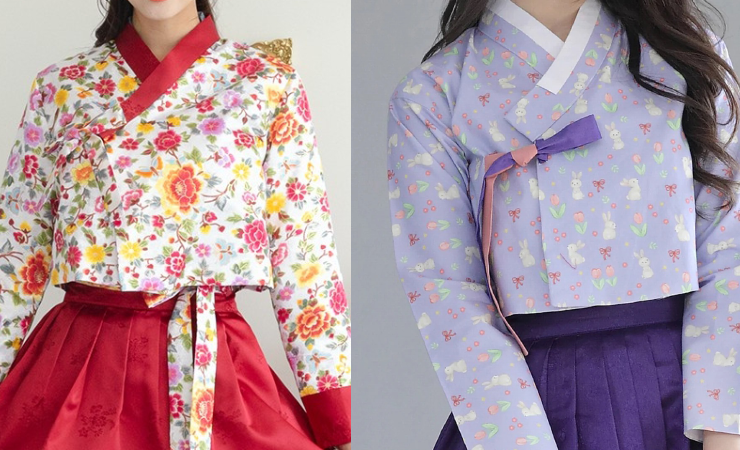
Korean traditional clothing, or Hanbok, embodies centuries of cultural and aesthetic values. Known for its graceful curves, vivid colors, and symbolic significance, Hanbok serves as an artistic expression of Korean identity. This guide explores key pieces and accessories for men and women, showcasing the diversity and beauty of traditional Korean attire.
Traditional Clothing for Women
Jeogori (저고리)

Jeogori is a short, jacket-like garment that forms the upper part of the Hanbok. It has long, flowing sleeves and is fastened at the front with a ribbon called a goreum, which adds an elegant touch to the outfit. Traditionally, the length, design, and material of the Jeogori would reflect the wearer’s social status and age, with silk or fine cotton reserved for special occasions. Jeogori often features intricate embroidery or patterns, making it both functional and decorative.
Chima (치마)

The Chima is a full-length, high-waisted skirt worn over a sokchima (inner petticoat) to create volume and flow. The wide, pleated structure of the Chima allows for ease of movement while maintaining a graceful silhouette. Typically, the Chima is made of vibrant, colorful fabrics, with red and pink shades favored for weddings and celebratory events. Its design symbolizes modesty and elegance, an essential aspect of traditional Korean aesthetics.
Durumagi (두루마기)

Durumagi is an outer coat, often worn over the Jeogori and Chima for additional warmth or a more formal appearance. This long garment is characterized by its clean lines and simple elegance, often crafted from silk or fine cotton. In colder seasons, the Durumagi might be padded or lined with fur for insulation. It signifies dignity and formality, commonly worn for ceremonies or visits of respect.
Norigae (노리개)

Norigae is a decorative pendant that hangs from the Jeogori or Chima, serving as both an accessory and a charm. These ornaments often feature intricate knots, tassels, and carvings of auspicious symbols, such as lotus flowers or butterflies. Historically, Norigae was believed to bring good fortune and ward off evil spirits. They come in various sizes and designs, reflecting the personal taste and social standing of the wearer.
Traditional Clothing for Men
Jeogori (저고리)

The male Jeogori, though similar in structure to the women’s version, is designed with a straighter and more practical fit. It is a long-sleeved jacket tied at the front with simple ribbons, emphasizing function over embellishment. Traditionally, men’s Jeogori would be made from cotton or silk, depending on the occasion and their social class. It is often paired with baji (pants) to complete the basic Hanbok ensemble.
Baji (바지)

Baji are loose-fitting trousers designed for comfort and mobility, essential in Korea’s agrarian society. The wide legs taper at the ankle and are secured with ties or elastic bands, ensuring a snug fit. Made from breathable fabrics like cotton or linen, Baji allows freedom of movement, making them practical for both daily wear and formal occasions. For ceremonial purposes, they are often crafted from luxurious materials such as silk or satin.
Gat (갓)

The Gat is a traditional wide-brimmed hat made of horsehair and bamboo, historically worn by men of the noble yangban class. It has a semi-transparent brim and a rounded crown, often secured with a string under the chin. The Gat symbolizes social status and authority, with different styles and sizes indicating rank or age. Wearing a Gat was considered a mark of respectability and decorum in Joseon-era Korea.
Jogakbo (조각보)

Jogakbo is a traditional patchwork cloth used to wrap belongings or gifts, reflecting Korea’s resourceful craftsmanship. Each piece of fabric in the Jogakbo is carefully stitched together, creating a harmonious blend of colors and patterns. It serves both practical and aesthetic purposes, often repurposing leftover materials to create something beautiful and functional. Jogakbo is also a symbol of love and care, as it was frequently handmade by mothers or grandmothers.
Distinct Features of DPRK (North Korea) Traditional Clothing

In North Korea, traditional Hanbok retains its foundational design but reflects the state’s focus on modesty and simplicity. Colors tend to be muted, favoring soft blues, grays, and whites, with less emphasis on vibrant or luxurious materials. Additionally, Hanbok in the DPRK often lacks the intricate embroidery or embellishments commonly seen in South Korean counterparts, aligning with the state’s egalitarian ethos.
Modern Korean Clothing

Modern South Korean fashion blends traditional and contemporary styles, often incorporating Hanbok-inspired elements like Chima silhouettes or Jeogori-style tops into casual or formal wear. In contrast, North Korean clothing remains more conservative, with practical and uniform-like attire dominating everyday fashion. Despite this, both regions share a common appreciation for functional, climate-appropriate, and culturally expressive clothing.






